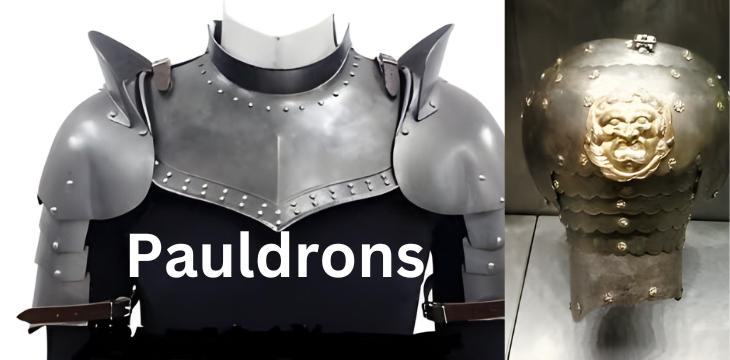Discover everything you need to know about pauldrons, from their historical significance to their modern-day use in armor crafting. Arm yourself with knowledge and dive into the fascinating world of pauldron.
Table Of Contents
Introduction:
Pauldrons, the iconic shoulder armor pieces worn by knights and warriors throughout history, have captured the imagination of many. From their origins in medieval times to their adaptations in contemporary armor design. Pauldron continue to stand as a symbol of strength and protection. In this comprehensive guide, we will explore the intricate details and rich history of pauldron, shedding light on their evolution. Construction, and significance in both past and present contexts.
1. Unveiling the History of Pauldrons
1.1 Origins in Medieval Warfare
Delve into the medieval origins of pauldrons. Tracing their roots back to the battlefield tactics and armor advancements of the Middle Ages.
1.2 Evolution of Design Pauldrons
Explore how pauldron designs evolved over time. From simple protective plates to elaborate and decorative pieces reflecting the fashion and function of their era.
1.3 Symbolism and Cultural Significance
Uncover the symbolic meanings associated with pauldrons in various cultures and societies. From representations of nobility to embodiments of martial prowess.
2. Anatomy of Pauldrons
2.1 Components and Structure
Examine the anatomy of pauldrons, including the various components such as spaulders. Besagews, and couters, and how they fit together to provide optimal protection and mobility.
2.2 Materials and Construction
Learn about the different materials used in crafting pauldrons, from traditional metals like steel and iron to modern alternatives such as titanium and carbon fiber.
2.3 Artistic Elements Pauldrons
Appreciate the artistic intricacies of pauldron design, from etched patterns and engraved motifs to embellishments like rivets, studs, and gemstones.
3. Practical Applications of Pauldrons
3.1 Historical Reenactment and LARPing
Discover how pauldrons are utilized in historical reenactments and Live Action Role-Playing (LARP) events, bringing the spirit of the past to life through authentic armor replicas.
3.2 Modern Armor Crafting
Explore the role of pauldrons in contemporary armor crafting, whether for cosplay, theatrical productions, or functional purposes in sports such as HEMA (Historical European Martial Arts).
3.3 Collecting and Conservation
Learn about the art of collecting and preserving antique pauldron, including techniques for restoration and maintenance to ensure their longevity and historical integrity.
4. Famous Pauldrons Throughout History
4.1 Iconic Examples
Highlight famous examples of pauldron from history, such as those worn by renowned knights, generals, and warriors, showcasing their unique designs and historical significance.
4.2 Museums and Exhibitions Pauldrons
Explore museums and exhibitions dedicated to showcasing the beauty and craftsmanship of pauldrons, providing a glimpse into their storied past and enduring legacy.
5. Maintaining and Caring for Pauldrons
5.1 Cleaning and Maintenance
Learn best practices for cleaning and maintaining pauldron to prevent rust, corrosion, and other forms of degradation.
5.2 Storage and Display
Discover tips for proper storage and display of pauldron to protect them from damage and ensure their pristine condition for years to come.
6. Frequently Asked Questions (FAQs) About Pauldron
How did pauldron get their name?
The term “pauldron” is derived from the French word “paulière,” which refers to shoulder armor.
Are pauldrons still used in modern military armor?
While traditional pauldron commonly use in modern military armor, variations of shoulder protection incorporated into some specialized gear and ballistic vests.
Can pauldrons be customized for cosplay purposes?
Yes, pauldron are often customized for cosplay, allowing enthusiasts to recreate iconic characters and historical figures with authentic armor replicas.
What is the difference between pauldron and spaulders?
Pauldron typically cover the entire shoulder area and extend down the upper arm, while spaulders are smaller shoulder guards that cover only the upper portion of the shoulder.
Do pauldron restrict movement?
Properly fitted pauldron should not significantly restrict movement, as they are designed to allow for a full range of motion while providing adequate protection.
Are pauldron purely decorative, or do they serve a functional purpose?
While pauldrons can have decorative elements, their primary function is to protect the shoulder and upper arm from injury during combat or other hazardous activities.
Conclusion:
In conclusion, pauldrons stand as a testament to the ingenuity, craftsmanship, and martial heritage of humanity. From their humble beginnings on the battlefield to their modern-day adaptations in cosplay and historical reenactments, pauldron continue to fascinate and inspire. Whether as symbols of power and prestige or as practical pieces of protective gear, these iconic shoulder armor pieces hold a timeless allure that transcends generations.


